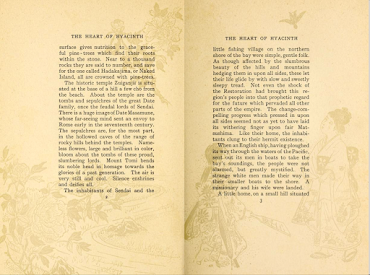The Heart of Hyacinth
Onoto Watanna [Winnifred Eaton]
New York: Harper, 1903
251 pages
Onoto Watanna [Winnifred Eaton]
New York: Harper, 1903
251 pages
Read last month, I've put off writing about The Heart of Hyacinth because I still don't know what to think.
To begin with, this is a novel written by a Canadian of Chinese and Scots heritage, born and raised in Montreal, who passed herself off as Japanese. The story takes place in Japan, which the author had not visited.
It's a beautifully written work. The opening pages seduce with descriptions of Sendai and the surrounding countryside. Minute, seemingly insignificant elements are added. All is dreamlike and idyllic. At some point a kindly Presbyterian missionary couple land. A modest church is built and there are some converts to the faith. Years pass, the minister's hair grows white, and his beloved wife dies. Then comes an English vessel carrying ill-behaved sailors and officers. They woo the daughters of Sendai, only to leave them; but one Englishman stays behind. He brings a young woman, Aoi, to the elderly missionary, and they marry. There the Englishman stays, loving his newfound land, loving his wife even more, and fathering a son. All of a sudden, the Old World – his old world – descends into conflict, and he is called to join the battle.
Aoi awaits a promised return that is not to be. After a lengthy silence, letters arrive in a foreign script and language. She takes them to the missionary who informs that her husband is dead.
Komazawa, the fatherless son, is a carefree child, unaffected by all that has passed. His life changes with the arrival of a dying "white" woman in the family home. She has brought with her a baby girl. The local doctor recommends that an English counsel be informed, but the boy balks; the white woman has entrusted the infant, Hyacinth, to his mother, and in her arms she will stay. If anything, the son is the greater protector and teacher of the girl.
The Heart of Hyacinth is a stone skipping across a lake. It touches fleetingly on scenes and events, leaving the reader to imagine what has happened in between. The ageing missionary reaches the point at which he must hand the mission to another. His replacement, Mr Blount, has the strength that comes with youth, but is in every other way a lesser man. He lacks his predecessor's appreciation of the local people and their culture; love is absent.
At Blount's insistence, the adolescent Komazawa is sent off to study in England:
"He is, in fact, one of us. He has the physical appearance, somewhat of the training, and, let us hope, the natural instincts of the Caucasian. It would be not only ludicrous but wicked him to continue here in this isolated spot, where he is, may we say, an alien."Komazawa does not return until four years later. In his absence, Hyacinth attends school in Sendai. Classmates laugh, pointing at her brown hair, and the sensei views the girl as a curiosity. She is taught that people from the West are barbarians and savages. When Komazawa reappears in English clothing, Hyacinth shuns him. When he changes into Japanese dress they embrace.
Hyacinth knows she is the adopted daughter of Aoi, whom she considers her mother. Born and raised in Japan, the girl thinks of herself as Japanese. Crisis comes with her betrothal to Yamashiro Yashida, son of the wealthiest family in Sendai. In opposing the union, Blount discovers that Aoi is not Hyacinth's natural mother – like the Yamashiro family, he had assumed that she and Komazawa shared the same parents. Then comes the discovery that both of the girl's parents were "Caucasian." The revelation comes as no surprise to the reader, who will remember her mother's dying hours, but to Hyacinth it is shocking and devastating.
The Heart of Hyacinth is a novel about identity and self-identity. At its heart – there is no better word – it confronts issues of race and nationality, questioning how we perceive ourselves and others. The beauty of its prose contains an ugly reality that sadly remains twelve decades later.
Object: The Heart of Hyacinth is one of the most beautiful books in my collection. The "decorations," which appear on every page, are credited to Kiyokichi Sano, about whom I can find next to no information.
I'm not so sure whether his hand also produced the four full-colour book plates. I suspect not.
My copy was purchased four years ago in Toronto.
Access: In 2000, after languishing out-of-print for nearly a century, The Heart of Hyacinth was revived by the University of Washington Press. Its edition includes an introduction by Samina Najmi.
Remarkably – astonishingly – copies of the 120-year-old first edition can be purchased online for as little as US$3.25. An Ontario bookseller hopes to sell his for US$105.00, but the one to buy is offered by a bookshop in Bridgewater, Nova Scotia. Wrapped in wax paper in original presentation box, it can be purchased for US$71.65.
I expect it to be gone within minutes of this post.
No one who buys this novel will be disappointed.
No one who buys this novel will be disappointed.
The Heart of Hyacinth can be read online through this link to the Internet Archive.












Hey Brian. Thanks for this. What an incredible book. I’ve just purchased it from the seller in Bridgewater
ReplyDeleteI wonder if being Chinese and Scottish might predispose one, particularly at the time, to be drawn to Japanese themes and culture. Britain as a whole and Japan have had some oddly (or, given their geographical positions at the edges of vastly world-changing historic empires, not so oddly) parallel development. Not least the rather sated, if briefly in comparison, lust for empires of their own.
ReplyDelete